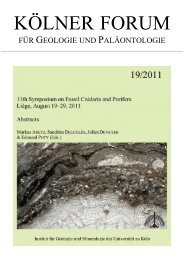Download (6Mb) - USP Electronic Research Repository - The ...
Download (6Mb) - USP Electronic Research Repository - The ...
Download (6Mb) - USP Electronic Research Repository - The ...
Create successful ePaper yourself
Turn your PDF publications into a flip-book with our unique Google optimized e-Paper software.
Chondria dasyphylla (Woodward) C. Agardh 1817: xviii; Weber-van Bosse 1923: 352;<br />
Taylor 1960: 616; Durairatnam 1961: 74, pl. 19, figs 10-1 1; Chapman 1963: 145, fig. 150;<br />
Jaasund 1976: 135, fig. 274; pl. 9; Dawes 1974: 155; Ngan and Price 1979: 16; Gordon-Mills<br />
1987: 246, figs 30-57; Lewis and Norris 1987: 22; Santelices and Abbott 1987: 9; Silva et<br />
al. 1987: 63; Garrigue and Tsuda 1988: 64; Tsuda 1991: 50; Verheij and Prud'homme van<br />
Reine 1993: 172.<br />
Fucus dasyphyllus Woodward 1794: 239, pl. 23, figs 1-3 (syntype localities: Cromer and<br />
Yarmouth, Norfolk, England).<br />
(Figs 134, 188a, b)<br />
Plants dark red, up to 30 mm high, with sparse and broadly pyramidal branching. Main<br />
axis 1-1.5 mm in diameter; branchlets single or clustered, constricted at the base and retuse<br />
at the apex, with central apiculus bearing a tuft of trichoblasts. Axial cell surrounded by 5<br />
pericentral cells, each 88-120 pm in diameter. Cortex composed of 3 layers, the outermost<br />
of small oblong cells up to 12 Fm in diameter; cortical cells angular in surface view. Plants<br />
sterile.<br />
Distribution<br />
Fiji, New Caledonia, Easter Island, northern Australia, Indonesia, Taiwan, Ryukyu Island,<br />
Philippines, Jamaica, tropical Americas, Caribbean, Ceylon, Tanzania, Europe.<br />
Fijian Records<br />
Garbary et al. 1991: 254; South and Kasahara 1992: 65.<br />
Rotuman Distribution<br />
Kelega; Lopta; Tua'koi (TI41 <strong>USP</strong> 475).<br />
Habitat and Remarks<br />
Found attached to coral rubble in tide pools, middle reef. In view of the need for a<br />
revision of the non-European records of Chondria dasyphylla (see Gordon-Mills 1987), the<br />
Rotuman plants cannot be firmly ascertained to belong to that species, although in vegetative<br />
characters they agree with the descriptions given by Taylor (1960) and Gordon-Mills (1987).<br />
Chondria sedifolia Harvey 1853: 19, pl. XVIII: G (type locality: Key West, Florida,<br />
USA); Taylor 1928: 171, pl. 34, fig. 11; 1960: 615; Chapman 1963: 145, fig. 149; Dawes<br />
1974: 155; Jaasund 1976: 135, fig. 273a, b; pl. 9; Silva et al. 1987: 63.<br />
(Figs 189, 191a, b)<br />
Plants dull reddish-purple, up to 40 mm high forming compact entangled mats, coarse and<br />
firm to the touch. Main axis percurrent, 400-600 pm in diameter. Branching broadly<br />
pyramidal; branchlets 400-500 bm in diameter, erect-spreading and constricted at the base,<br />
club-shaped with truncated distal ends bearing a tuft of trichoblasts. Axial cell spherical,<br />
25-28 p,m in diameter and surrounded by 5 pericentral cells 62-68 pm in diameter. Medulla<br />
composed of loosely-packed ovoid cells 40-45 pm in diameter. Cortex 2-layered; the<br />
lowermost of obovoid cells 12-15 Fm in diameter, the uppermost of subrectangular cells up<br />
to 3 pm in diameter. Cortical cells rounded and loosely-packed in surface view.<br />
Tetrasporangia cruciate, dark red, 75-100 pm in diameter, clustered near the apices of fertile<br />
branchlets.<br />
Distribution<br />
Fiji, Philippines, Caribbean, north America, Tanzania.

















